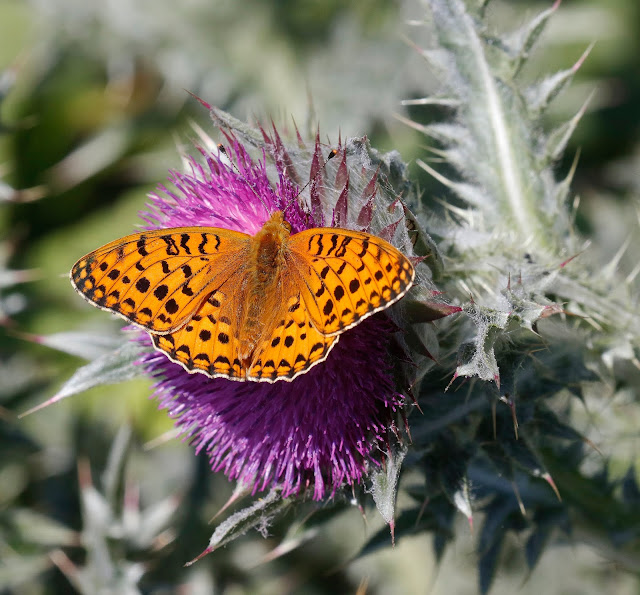Sunshine heralded the beginning of another month and another day of butterflying.This time I took myself to Aston Rowant in search of Dark Green Fritillaries. In contrast to the various species of smaller fritillaries I took such great pleasure in seeking out in May, Dark Green Fritillaries are large, flying from the beginning of June, but earlier this year due to the good weather, with a flight that is both rapid and powerful but still allows the butterfly to maintain a supreme grace of movement. These magnificent insects cruise the downland sward in great sweeping glides or with a fast fluttering flight, inches above the ground as the males search for emerging virgin females to mate with.
The short grass of the south facing scarp slope I chose to wander has long since dried to a brittle yellow that crackles below my tread, dessicated by sun that has shone virtually continuously throughout a May that has been the sunniest on record. However there is still an underlying emerging vegetation of green; low lying bramble, stunted dogwood and herbs such as thyme and marjoram capable of resisting the drought. The many white heads of oxe eye daisies and the smaller yellow heads of catsears persist, the taller daisies nodding to the gentle southeast wind, both plants contriving to bring colour and variety to the parched landscape.
A large clump of Musk Thistle stood out on the slope, a plant to approach with care as its green leaves and stems, furred grey, are armed with long and sharp spines, the stems supporting a number of cerise pink flowerheads, bent slightly downwards as if too heavy for the stem that bears them, each flower head shaped into a bulging replication of a shaving brush.
I was not the only one to notice the thistle and its large flowerheads as no less than six Dark Green Fritillaries were tripping, on hair thin legs, over the blooms, their probosces curved into each tiny purple floret, the thistle transformed into a fritillary filling station. In and out, in and out they probed in a rapid progression as they plundered the flowerheads, guzzling each minute drop of nectar, balancing like acrobats, never discomfited even as they progressed upside down in examining every possible part of the flowerhead. Two sometimes three clustered on a flowerhead.
It was still early enough in the day for the butterflies to be garnering energy from the sun by holding their ginger orange wings wide open but they reached a point where they began to flex their wings, slowly moving them from open to almost closed and then open again, a gentle regular movement, up and down. A movement of contentment and fulfilment, as if embracing the sun's heat to their furry bodies. Then, finally satisfied, deciding to close their wings altogether.
It was still early enough in the day for the butterflies to be garnering energy from the sun by holding their ginger orange wings wide open but they reached a point where they began to flex their wings, slowly moving them from open to almost closed and then open again, a gentle regular movement, up and down. A movement of contentment and fulfilment, as if embracing the sun's heat to their furry bodies. Then, finally satisfied, deciding to close their wings altogether.
With wings closed the butterfly reveals the origin of its name. The underwings are suffused with a base colour of pale olive overlaid with irregular shapes of white. As the butterfly explores the flowerhead the change of angle causes its wings to become lighter and the white markings shine like silver fish scales as they reflect the sun, Another move, the angle changes and the wings become darker and the white markings no longer sparkle.
All six were males but there was little rancour amongst them as they shared a flowerhead. There was much coming and going as the restless insects departed to cruise around nearby before returning to the flowers to top up their energy. Sometimes they would briefly settle on a bramble leaf nearby to sun themselves but the lure of thistle nectar always proved too great to resist and they would soon return.
I left them and walked the slope finding many more, each individual flying fast and low on a quest for a female. Flickering an inch or two above the ground they endlessly quartered, diverting to examine some nook in the ground hugging vegetation where a female might be hiding or intercepting a flying Meadow Brown, in an unfortunate case of mistaken identity, the two spiralling in mutual confusion which was soon over as the fritillary realised its error, broke away and resumed its tireless search for a female.
For two hours I wandered the sheep tracks back and fore, reluctant to leave. It was all here, bringing that which I desired, an anchorage of peace and calm for a mind in turmoil in a much troubled world.I had long since abandoned any desire to photograph the fritillaries and succumbed once more to the charm of this, one of my favourite places, untroubled by few visitors.
For two hours I wandered the sheep tracks back and fore, reluctant to leave. It was all here, bringing that which I desired, an anchorage of peace and calm for a mind in turmoil in a much troubled world.I had long since abandoned any desire to photograph the fritillaries and succumbed once more to the charm of this, one of my favourite places, untroubled by few visitors.



















No comments:
Post a Comment